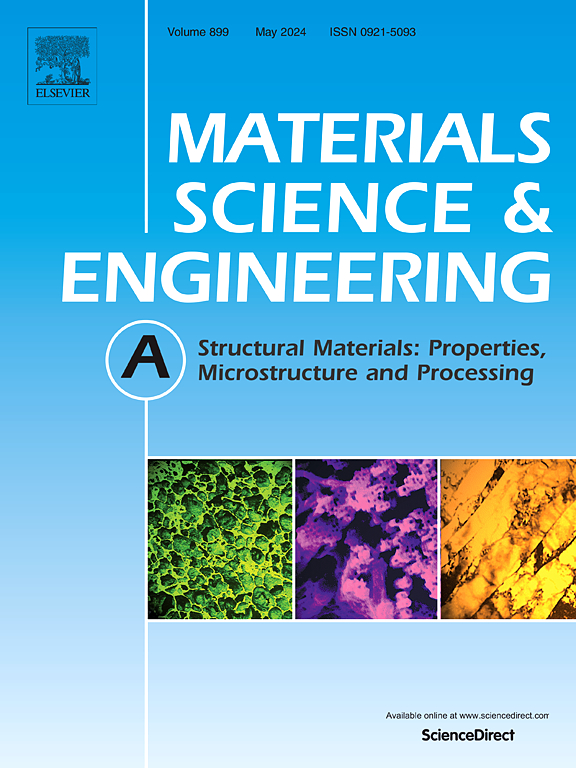The effect of partial surface strengthening on the strength and plasticity of Ti6Al4V titanium alloy
IF 7
2区 材料科学
Q1 MATERIALS SCIENCE, MULTIDISCIPLINARY
引用次数: 0
Abstract
This study implemented ultrasonic surface rolling processing (USRP) and partial ultrasonic surface rolling processing (PUSRP) on TC4 titanium alloy to construct a bidirectional heterostructure (BH) through controlled rolling-zone width modulation. The BH comprises: (Ⅰ) axial grain gradient heterostructure spanning surface to subsurface layers, and (Ⅱ) radial structural heterostructure between rolled and unrolled zones. Notably, USRP-treated samples exhibited premature fracture due to diminished dislocation accommodation capacity in fully deformed regions. In contrast, PUSRP specimens demonstrated significant tensile property enhancements over both matrix and USRP specimens. Crucially, geometrically necessary dislocations (GNDs) at heterogeneous boundaries generated substantial back stress during loading, inducing hetero-deformation induced (HDI) stress strengthening. The stacking behavior of GNDs in both directions was analyzed by microhardness, EBSD and dual-beam diffraction, confirming the multiaxial stress states were activated in both radial (rolled zone) and axial (unrolled zone) directions, promoting additional ⟨c + a⟩ slip system activation in unrolled regions that synergistically enhanced HDI strengthening and ductility-stability coordination. However, excessive unrolled zone width (∼6 mm) restricted HDI strengthening propagation, yielding mechanical properties comparable to untreated matrix. This phenomenon of bidirectional heterostructure strengthening provides a new perspective for the preparation of titanium alloy components with excellent mechanical properties.
局部表面强化对Ti6Al4V钛合金强度和塑性的影响
本研究对TC4钛合金进行超声表面轧制加工(USRP)和局部超声表面轧制加工(PUSRP),通过可控轧制区宽度调制,构建双向异质结构(BH)。BH包括:(Ⅰ)跨越表层到次表层的轴向晶粒梯度异质结构和(Ⅱ)轧制区和未轧制区之间的径向结构异质结构。值得注意的是,usrp处理的样品由于完全变形区域的位错调节能力降低而出现过早断裂。相比之下,PUSRP样品比基体和USRP样品都表现出显著的拉伸性能增强。关键是,在非均质边界处的几何必要位错(GNDs)在加载过程中产生了大量的背应力,导致非均质变形诱导(HDI)应力强化。通过显微硬度,EBSD和双光束衍射分析了GNDs在两个方向上的堆积行为,证实了多轴应力状态在径向(轧制区)和轴向(展开区)方向上都被激活,促进了在展开区域中额外的⟨c + a⟩滑移系统激活,从而协同增强了HDI强化和延性-稳定性协调。然而,过大的展开区宽度(~ 6mm)限制了HDI强化传播,产生的力学性能与未处理的基体相当。这种双向异质结构强化现象为制备具有优异力学性能的钛合金部件提供了新的视角。
本文章由计算机程序翻译,如有差异,请以英文原文为准。
求助全文
约1分钟内获得全文
求助全文
来源期刊

Materials Science and Engineering: A
工程技术-材料科学:综合
CiteScore
11.50
自引率
15.60%
发文量
1811
审稿时长
31 days
期刊介绍:
Materials Science and Engineering A provides an international medium for the publication of theoretical and experimental studies related to the load-bearing capacity of materials as influenced by their basic properties, processing history, microstructure and operating environment. Appropriate submissions to Materials Science and Engineering A should include scientific and/or engineering factors which affect the microstructure - strength relationships of materials and report the changes to mechanical behavior.
 求助内容:
求助内容: 应助结果提醒方式:
应助结果提醒方式:


